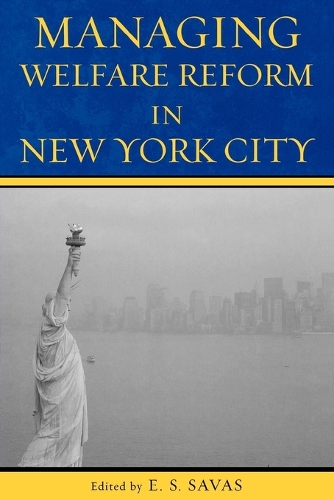
Managing Welfare Reform in New York City
(Paperback)
Publishing Details
Managing Welfare Reform in New York City
By (Author) E. S. Savas
Contributions by Burt S. Barnow
Contributions by Douglas J. Besharov
Contributions by James Clark
Contributions by Sanders Korenman
Contributions by Arthur L. Levine
Contributions by Thomas J. Main
Contributions by Demetra Smith Nightingale
Contributions by June O'Neill
Contributions by Sally Satel
Bloomsbury Publishing PLC
Rowman & Littlefield Publishers
6th October 2005
United States
Classifications
General
Non Fiction
361.68097471
Physical Properties
Paperback
392
Width 186mm, Height 227mm, Spine 22mm
494g
Description
Welfare reform was a spectacular success in New York under Mayor Giuliani despite the city's history of liberal social programs and its huge, entrenched welfare system. The city reduced the numbers on welfare from 1,120,000 to 460,000 by changing the organizational culture, protecting against fraud, insisting on "work first," adapting information technology, and contracting for job placement.
The organizational culture was transformed by bold leadership that changed the welfare agency's mission and goals, overcame internal resistance, and prevailed over politicians who had a vested interest in the status quo and the media that were opposed to welfare reform.
Welfare fraud was largely eliminated by dropping from the rolls those who were working and could not appear for in-person interviews, by fingerprinting recipients to catch those enrolled under multiple identities and those receiving welfare checks from other jurisdictions, by uncovering hidden income, by enrolling new applicants only after thorough investigation, and by tightening controls to prevent fraud by corrupt employees.
JobStat, a computer-based system modeled after the Police Department's system used to track precinct activity, was developed to track the status of welfare recipients and to monitor the performance of the "Job Centers," which were formerly called welfare offices. JobStat focused the attention of department personnel on performance indicators rather than on minutely specified rules.
The Giuliani administration's major contribution to national welfare reform was the creation of the only system in the country with large-scale, alternative work arrangements that was able to acculturate large numbers of the never-employed to the world of work.
Author Bio
E. S. Savas is professor of public affairs at Baruch College, CUNY. He is the (co)author/(co)editor of more than a dozen books, including: Privatization in New York: If You Can Do It Here, You Can Do It Anywhere; The New Public Management: Lessons from Innovating Governors and Mayors; and Privatization and Public-Private Partnerships. He has contributed to dozens of books and written dozens of scholarly articles. Professor Savas has been named one of the Great Contributors to Public Administration by Public Administration in the New Century and Grover Starlings classic, Managing the Public Sector, lists Savas work as one of 41 Highlights in the Intellectual History of American Public Administration.
